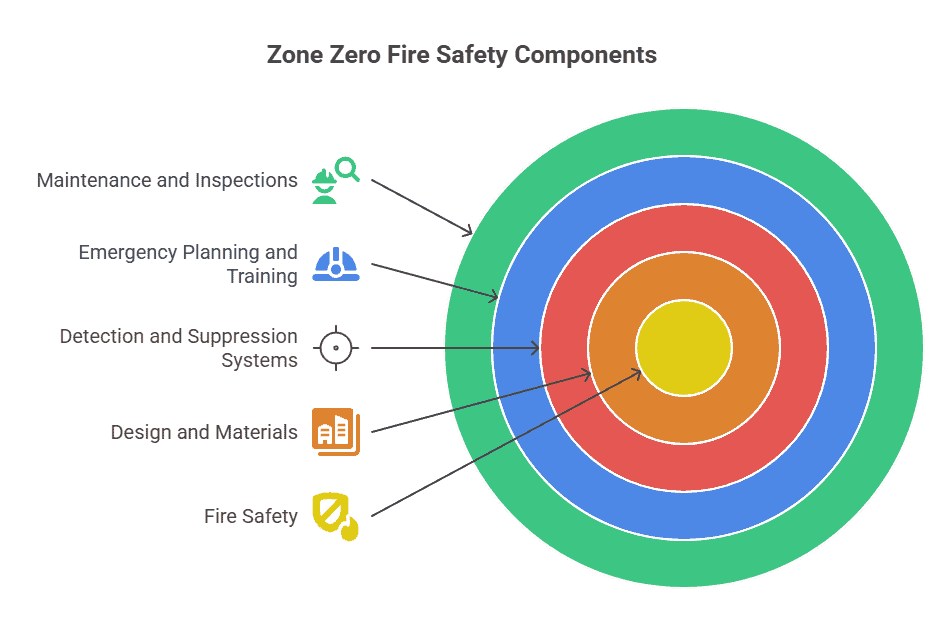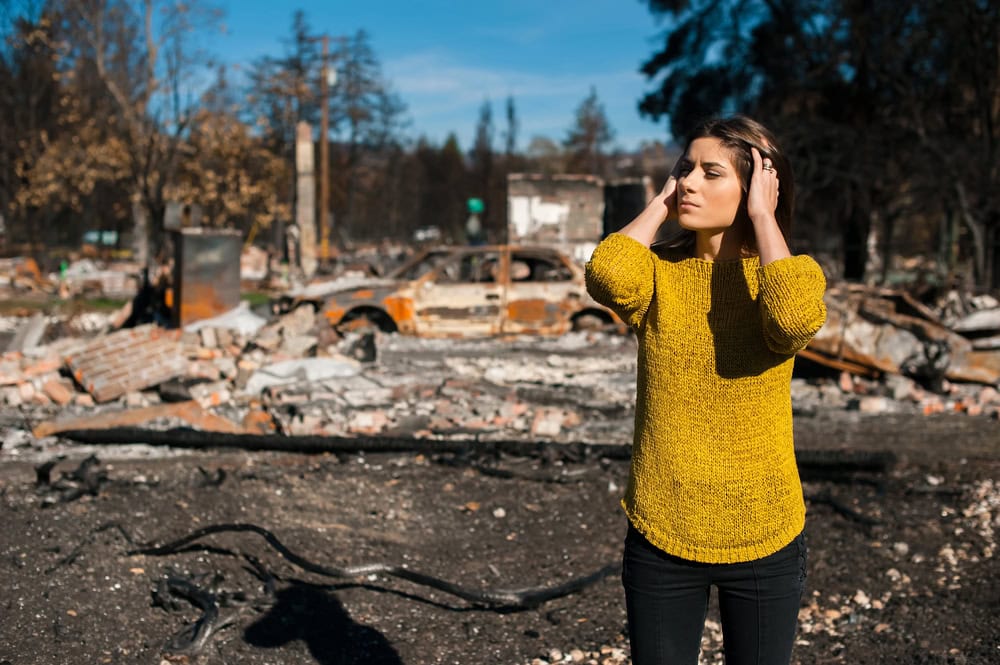The term “home hardening” for wildfire protection refers to intentional efforts that increase a home and property’s resistance to damage and destruction from wildfires. Aluminum is a fencing choice that contributes to the process of home hardening for wildfire protection.
The first step in home hardening is to think about your property as a defensible space. Within that space, one of the most critical areas is called “zone zero.”
Zone zero refers to the home structure(s) and everything within the surrounding five feet from your home. Using non-combustible aluminum fencing and other materials that meet current fire safety standards is critical to a home’s zone zero protection plan. Efforts from statewide and local organizations—such as Bay Area fire departments, Bay Area building and zoning departments, and home insurance companies—to promote preventative fire safety measures in zone zero mean noncombustible building and fencing materials are becoming the norm.

Aluminum and other fire-hardened fencing products matter because they can mean the difference between minimal fire damage and catastrophic damage to your home and property compared with their flammable counterparts. They are also a fire marshal-approved flame and ember-resistant building material.
Implementing the right type of fencing and property-relevant hardening techniques, using flame-resistant products and best practices, creates defensible space to protect your home and property—and minimizes adjacent house fire threats.
Understanding Fire-Resistant vs. Combustible Fencing and Gate Materials
Fire-resistant fence and gate materials are those that are difficult to catch on fire or only burn/melt at exceptionally high rates. So, for example, if an ember from a local wildfire makes its way into your defensible space (zone zero) and hits a fire-resistant or noncombustible material, the ember is more likely to burn out or fall back away from the fenceline, preventing fencing from igniting.
Examples of fire-resistant fencing materials include:
- Aluminum fences
- Steel fencing
- Hogwire with metal posts (although fire can penetrate through grids and catch flammable ground litter or landscaping on fire)
- Hardie board
- Iron fence panels with minimal scrollwork
In contrast, combustible fencing materials are more likely to catch fire and, because they’re flammable, can exponentially contribute to the fire risk. Burning parts or sections of fence exacerbate the problem and act as an accelerant. This is especially true when there are high winds during a wildfire.
Examples of combustible materials include:
- Wood
- Wood-plastic composites
- Vinyl (while it can be modestly fire-resistant, firesafemarin.org states, “Vinyl fencing is not vulnerable to ember exposures alone, but does burn when subjected to flaming exposures from burning debris. Vinyl fencing will deform if subjected to radiant heat.”)
- Chain-link fences with privacy slats (even if the materials are inflammable, burning embers and debris can become trapped in the gaps or crevices, increasing the risk of your home catching fire)
It’s also worth noting that installing fire-resistant fencing options—along with additional steps to implement home hardening techniques and precautions to protect your home—makes homes and properties more insurable and can potentially lower home insurance premium rates.
How Fences Contribute to Your Home’s Wildfire Vulnerability
Combustible fencing and building materials diminish your efforts to create a defensible space because any flammable fencing materials become part of the problem. If a wood fence ignites, it accelerates the spread of sparks, embers, and flames into the zone zero area. And, if flammable fencing is attached to the home structure itself, it can be a direct conduit for fire to spread to your home.
On the other hand, non-flammable fencing and gates reduce potential home and property ignitions. Since embers or flames cannot catch noncombustible materials on fire, the fire burns out or chooses another path, which protects your home.
There are other things you can do when selecting a fence that supports fire suppression and protection:
- Choose fence panels with minimal scroll work or more intricate designs as they can trap embers and other burning debris
- Use iron, steel, or aluminum fence panels next to the home if you aren’t able to replace a wood fence just yet
- Replace wood fence posts with flame-retardant options
- If you can’t afford to replace your entire fence, work with a local, Bay Area fencing contractor to begin a scaled approach to replace combustible fencing with non-flammable alternatives

Cal Fire Guidelines for Fire-Resistant Defensible Space and Fencing
Key Cal Fire guidelines for defensible space and fencing include:
- Using fire-hardening products and building materials for fencing, hardscape structures, and the exterior of your home (fire-safe roofing, gutters, siding, and so on)
- Start with wildfire home hardening steps for your house structure, continuing to implement fire resistant tenets in the zone zero area, continuing to 30 feet, and working out to a 100-foot perimeter
- Keep it “lean, clean, and green” within 30 feet by minimizing flammable yard furniture/ornaments and keeping the landscape free of dry/flammable fodder. Finally, plant lots of green, fire-resistant trees, plants, and shrubs around your property
- Minimize the spread of fire by reducing potential or high-risk fuel around a 100-foot perimeter. This includes mowing annual grasses, creating vertical/horizontal space between trees/shrubs, and keeping the ground free of dried branches, twigs, dead pine needles/leaves, etc.
Maintaining your property’s defensible space and choosing non-combustible fencing reduces the risk of fire threat for you and your wider community.
Why is Fire Hardening With Aluminum Fencing Considered Fire-Safe for High-Risk Fire Areas?
Aluminum fencing is considered fire-safe because it is non-flammable, slowing or preventing a fire’s spread beyond the fence’s perimeter. Organizations dedicated to reducing fire risk consider aluminum a go-to material for anyone choosing a fire-safe fence.
The good news is that there’s no need to sacrifice aesthetics for function. Today’s aluminum fencing products can replicate more traditional fencing materials, including wood shake, so that you can benefit from a wood-look fence without its high flammability risk.
The Non-Combustible Properties of Aluminum Fences
Aluminum fencing is considered noncombustible because it doesn’t burn, which means it also prevents ember ignition. If smaller embers fall on or hit the fence, they’ll die out, further protecting your home from wildfires.
Even at temperatures as high as 750°C (1382°F), aluminum doesn’t catch fire. Instead, it melts. So, even if it is attached to your home, your aluminum fence can reduce fire exposure—or fire spread—by stopping embers or ignition potential in its tracks.
How Can You Replace Existing Combustible Fences to Harden Your Home?
Replacing existing combustible fences with aluminum options or other noncombustible options is as simple as scheduling an on-site appointment with Duce Construction Deck & Fence.
As long time Bay Area homeowners ourselves, we know firsthand how essential it is to prioritize fire resistance for your home, property, and family. Install gorgeous fencing solutions using fire-resistant building materials to make your home more resilient and prevent fire from spreading around the home. Contact us, and we’ll help you take the next critical step to prepare for wildfires.

